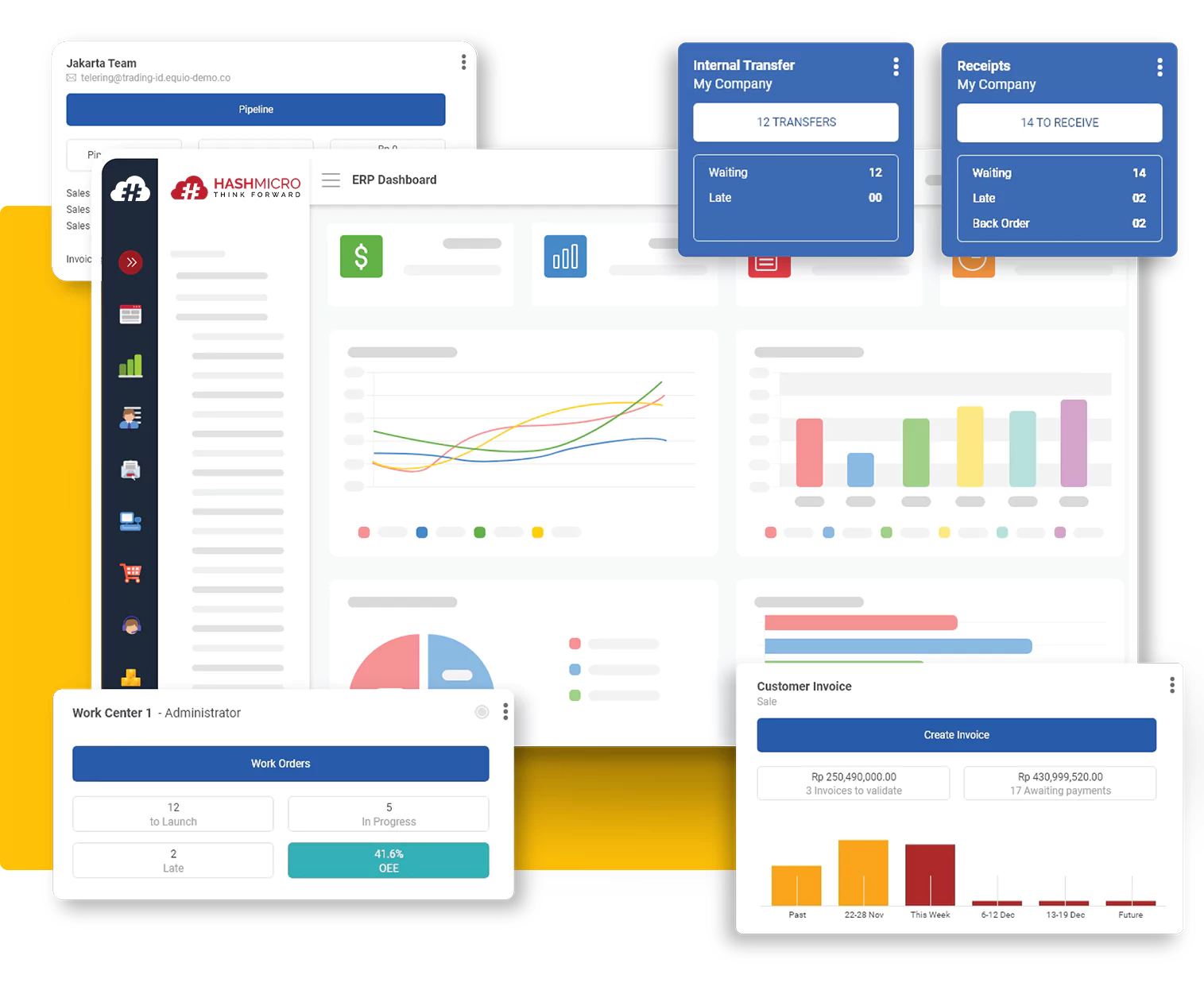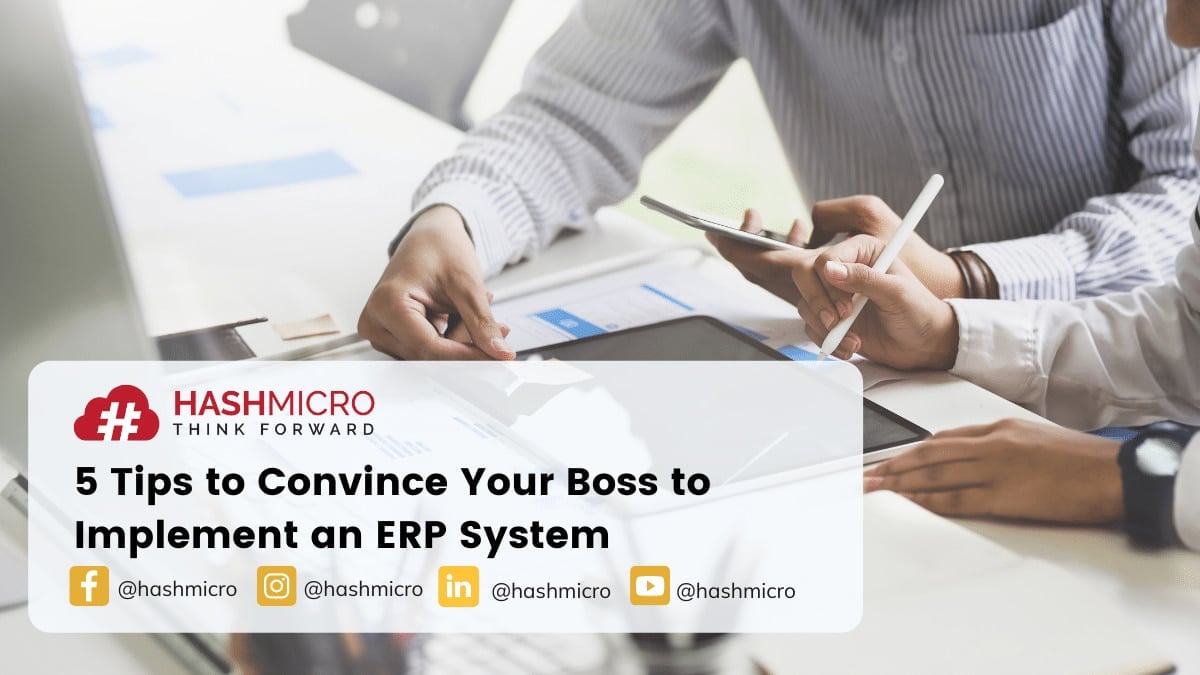I’ve been there, stuck juggling spreadsheets, disconnected systems, and endless manual tasks, wishing there was a better way. If you’ve ever felt the same, it might be time to talk to your boss about implementing an ERP system.
ERP (Enterprise Resource Planning) systems integrate multiple business processes — from finance to inventory- into one unified platform. While enterprises once dominated ERP adoption, today’s cloud-based solutions have made it accessible and essential for SMEs as well.
Still, convincing your boss to invest in a new system isn’t always easy. To help you out, here are five proven strategies to make your case and show why implementing a complete ERP system is the smartest move your company can make.
Key Takeaways
|
What is ERP Implementation?
ERP implementation is the process of setting up and configuring ERP software to connect different departments and functions within an organization. It ensures that key areas, such as finance, operations, sales, and HR, work together through a centralized system.
By integrating all these functions, businesses can achieve seamless data sharing, better communication, and improved efficiency. This unified approach enables organizations to make informed decisions based on real-time insights, while reducing redundancy and manual errors.
Challenges to Watch Out for in ERP Implementation
There are challenges to watch out for in ERP Implementation that you must consider, such as:
1. Lack of proper planning
Many ERP projects fail due to inadequate preparation. Without clear goals, realistic timelines, or sufficient resources, organizations risk delays and budget overruns. Proper planning ensures smoother implementation and better alignment with business objectives.
2. Poor data quality and management
Since ERP systems depend on accurate data, inconsistencies or errors can cause major disruptions. Businesses must clean, validate, and migrate their data carefully to maintain integrity and enable effective decision-making.
3. Limited executive and stakeholder support
ERP success relies heavily on leadership backing. Without it, teams may resist change or fail to cooperate. Gaining early buy-in from executives and stakeholders helps drive engagement and project momentum.
4. Neglecting change management
Implementing ERP often means redefining workflows and roles. Failing to manage change can lead to user resistance and reduced productivity. Providing proper training and open communication fosters smoother transitions.
5. Choosing the wrong ERP system or vendor
Selecting an ERP solution that doesn’t align with business needs can derail the project. Evaluate systems based on scalability, customization, and vendor reputation to ensure long-term success.
How to Assess the Effectiveness of Your ERP Implementation

Measuring the success of an ERP implementation is vital to ensure it meets business objectives and delivers tangible results. Companies should assess various performance areas to determine how effectively the system supports operations.
1. Key performance indicators (KPIs)
Evaluate the ERP system using measurable indicators such as uptime, efficiency, and accuracy. Track system reliability to minimize disruptions and assess process improvements in areas like order processing, inventory control, and financial management.
Gauge user adoption through feedback and satisfaction surveys, ensuring employees are confident using the system. Additionally, verify data integrity by checking the accuracy and consistency of reports.
2. System integration and scalability
Examine how well the ERP integrates with existing technologies and supports future business expansion. A successful ERP should seamlessly connect departments, handle increasing transaction volumes, and scale with organizational growth.
3. Continuous review and optimization
Implement feedback loops to collect input from users and stakeholders regularly. Conduct audits and performance reviews to ensure alignment with strategic goals and make necessary adjustments.
Benchmark progress against initial objectives to measure achievements and identify areas for improvement.
4. Communication and leadership support
Strong executive backing and transparent communication are key to ERP success. Maintain consistent engagement with stakeholders, keeping them updated on implementation progress, challenges, and milestones to sustain momentum and organizational alignment.
9 Tips for a Successful ERP Implementation
1. Explain Your Difficulty with Numbers
Your boss, be it the business owner, manager, or executive, speaks number only. So, the anecdote about how difficult your job is will not be enough to convince them. They want to know the impacts of your difficulty on their finance.
For example, how many percentages of customers left your stores because you did not predict, manage, and track the inventory properly? Then, try to compare this percentage with your competitors.
Providing them with qualitative data will make your proposal looks credible. Using tools like an AI proposal generator can help streamline the preparation of these documents and incorporate relevant data efficiently.
2. Show the ROI the company will get
The ROI in the context of ERP implementation is the metric that can be achieved after investing and using the system. You can easily explain the cost of the ERP but maybe not with the results. It is because the advantages of ERP are not always in number.
There are tangible and intangible benefits. Here are some of them that you can elaborate more on to ensure them.
Tangible benefits
- Reduced inventory waste thanks to better control and planning.
- The material cost that lower than previous because of automated and easily monitored procurement.
- Labor cost does not swell because the staff is allocated well.
- Improved production process due to good planning and maintained machines.
- Reduced sales cost.
Intangible benefits
- Business operations become efficient, transparent, and effective.
- Inventory stock is accurate with precise predictions.
- Customer service and delivery are improved.
- Procedures are standardized.
- Financial management becomes controlled by accounting software.
- Compliance with regulations is easier.
Related article: How to Successfully Conduct a Year-End Profit Review
3. Provide independent third parties
If the points above can strengthen your arguments, this point suggests you present your boss with a third party. They can be business consultants or IT teams who can provide further information about the benefits of ERP and the best plan to implement it.
Their expertise and experience in ERP implementation plan might assure your boss. You should also make sure that the third parties are independent and not affiliated with any ERP vendors.
4. Show your plan to minimize project risks
Nothing scares your boss more than project failure. So, don’t ever think to say that implementing an ERP System is free from any hassles. They may have researched companies that failed to set up ERP systems.
ERP Implementation plan can make your project management more effective and efficient. This is because the ERP system is able to plan all your activities from start to finish. So, your project is far from being a failure.
Instead of hiding the risks, explain to them your risk management plan to identify and mitigate the emerging issues. It’s better if you identify the possible issue and consider consulting the business consultant before explaining it to your boss.
In addition, to maximize projects, companies can use good project management software. This system will assist the company in communication, such as the distribution of tasks, accuracy in project completion, and utilization of available resources.
Read more: Business Plan: Definition, Benefits, and How to Make it Before Building a Business
5. Choose the vendor and system demo
You have prepared your arguments. Next, you should choose the best ERP vendor. Ask them for demos. It’s important because ERP is expensive and it changes your business tremendously. Preparing yourself the lists of vendors will help you explain it to the boss.
Determine the team responsible for selecting and evaluating the system. This team usually consists of IT staff, and third parties. Moreover, if possible, each department should have the opportunity to test the system, as it must adapt to business growth.
Don’t know which ERP vendor offers a free demo? Or worse, don’t even know where to start? Don’t worry; our article about the best ERP software in Singapore is ready to guide your first step into the ERP landscape.
6. Develop a comprehensive ERP implementation plan
Having a structured ERP implementation plan is vital to managing timelines, budgets, and team coordination effectively. This plan should clearly define:
- The main stages of implementation, including preparation, execution, and optimization
- Allocation of resources such as finances, tools, and personnel
- Backup strategies to handle unforeseen issues
A well-documented plan serves as a guide for all stakeholders, ensuring everyone understands their responsibilities and project milestones.
7. Focus on employee training and ongoing support
Employee readiness plays a major role in ERP success. Provide tailored training programs for users at different levels to ensure they understand both basic operations and advanced features.
Establishing a reliable support system helps employees resolve challenges quickly during and after deployment. Ongoing assistance ensures long-term efficiency and confidence in using the ERP system.
8. Conduct thorough testing before launch
Comprehensive testing is crucial before full deployment. Run functional, integration, and user-acceptance tests to detect and correct potential issues early. Involving end-users in this process ensures the system aligns with real operational needs and performs as expected once it goes live.
9. Evaluate and optimize after implementation
Post-launch monitoring helps maintain system performance and user satisfaction. Collect user feedback, review performance metrics, and make adjustments where necessary. Continuous evaluation and refinement allow the ERP system to evolve with the organization’s growth.
Here is a table summary that discusses about nine tips for a successful ERP implementation:
| Tips for a Successful ERP Implementation | Description |
| Explain Your Difficulty with Numbers | Translate your daily challenges into measurable business impacts. Use data and comparisons to show how inefficiencies affect revenue, customer retention, and competitiveness. |
| Show the ROI the company will get | Highlight both tangible and intangible benefits of ERP implementation. Demonstrate how it reduces costs, boosts efficiency, and improves overall business performance over time. |
| Provide independent third parties | Involve credible consultants or IT experts to validate your proposal. Their independent insights and experience can strengthen your case and build trust with decision-makers. |
| Share your plan to minimize project risks | Demonstrate a clear risk management strategy to reassure stakeholders. Identifying potential issues early and planning mitigation steps builds trust and prevents costly mistakes. |
| Choose the vendor and system demo | Select a reliable ERP vendor and request system demos to ensure compatibility with your business needs. Involve key teams in testing to guarantee the system supports every department effectively. |
| Develop a comprehensive ERP implementation plan | Create a detailed roadmap that outlines the project stages, resources, and contingency strategies. A structured plan keeps teams aligned, minimizes delays, and ensures smoother ERP adoption. |
| Focus on employee training and ongoing support | Prepare your team with targeted training for all user levels to boost confidence and productivity. A solid support system ensures quick problem resolution and sustained ERP efficiency. |
| Conduct thorough testing before launch | Conduct thorough testing to identify and resolve issues before going live. Involving end-users ensures the system aligns with daily workflows and runs smoothly after launch. |
| Evaluate and optimize after implementation. | Regularly review system performance and gather user feedback to ensure optimal functionality. Continuous improvement ensures your ERP remains aligned with your organizational goals and growth. |
Streamline Your ERP Implementation with HashMicro’s ERP System

HashMicro’s ERP System provides a comprehensive solution to simplify and automate business operations across various departments. The system enables companies to manage their financials, inventory, sales, procurement, and production all in one integrated platform.
With its high flexibility, businesses can customize workflows to align with their specific operational structures. This adaptability enables more efficient data management, smoother collaboration between teams, and better control over resources.
Key features of the HashMicro ERP System include:
- Automated Financial Management: Streamlines accounting processes, automates journal entries, and ensures accurate financial reporting.
- Inventory and Supply Chain Optimization: Tracks stock levels in real-time and improves supply chain efficiency through automated procurement and replenishment.
- Production and Resource Planning: Enhances production scheduling and capacity planning to minimize waste and optimize output.
- Data-Driven Insights: Provides real-time dashboards and analytics to help businesses make smarter, data-backed decisions.
- AI-Powered Automation: Hashy AI analyzes data patterns, detects anomalies, and offers predictive recommendations to improve operational efficiency.
Conclusion
Those are the 5 tips that you can use to convince your boss to implement an ERP System. In short, you should talk to them in their languages. Use facts, figures, and visuals to point out your arguments.
You should choose the best ERP software and point out its benefits. In this case, you could recommend a complete Hash Core ERP Software from HashMicro as it can help your company to streamline the business processes & drive your company’s growth significantly.
It can also help the company to create efficiency and productivity in every operational activity through various main features. Schedule a free demo now to experience the transformational power it brings to your operations.

Frequently Asked Questions
-
What is the first step in implementing an ERP system?
The first step is conducting a thorough assessment of your business processes and needs. This helps define goals, select the right ERP solution, and create a clear implementation plan that aligns with organizational objectives.
-
How long does it take to implement an ERP system?
Implementation timelines vary depending on company size, system complexity, and customization needs. On average, it can take anywhere from a few months to over a year to complete a successful rollout.
-
How can I ensure ERP implementation success?
Success depends on clear planning, strong leadership support, employee training, and continuous monitoring. Involving key stakeholders early and maintaining open communication throughout the process are also crucial for long-term success.














